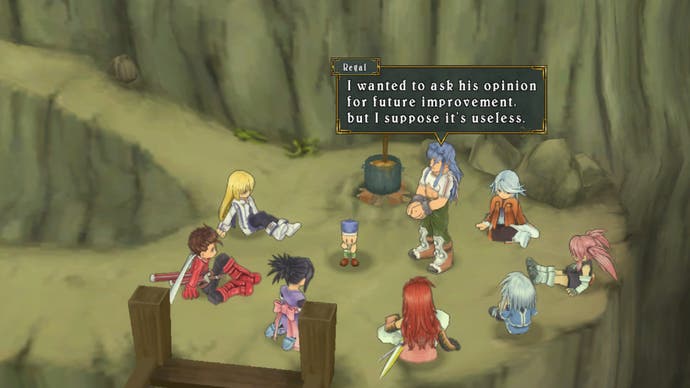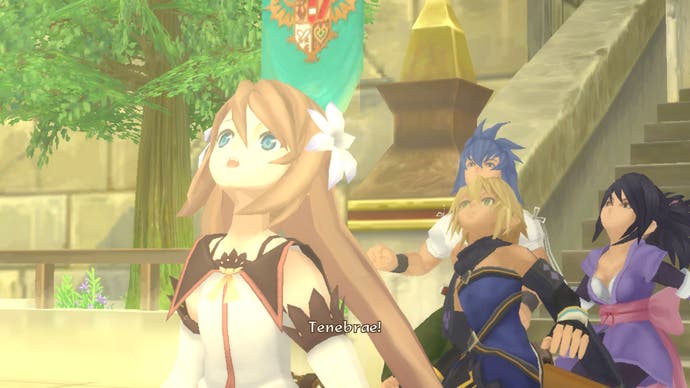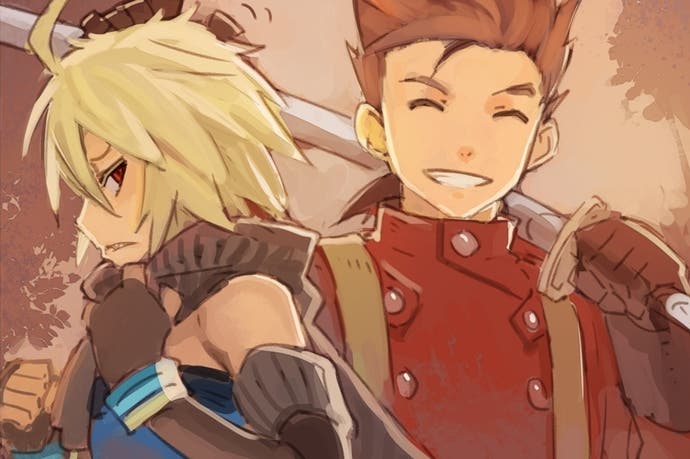Tales of Symphonia: Chronicles review
A tale of two games.
Typically, I don't get on with Japanese RPGs. I don't like the melodrama, the stilted writing, the often turn-based menu-battles - and I don't like that I seem to spend more time watching the game than playing it. I can't ever shake the feeling that my participation is incidental to the story that the writers want for me.
Almost 10 years ago, some friends sat me down and made me play what was probably the first JRPG outside of Pokémon that I actually enjoyed - Tales of Symphonia, now available in an HD reissue for PlayStation 3 which also includes its spin-off sequel Dawn of the New World. I've been struggling for years to explain why this game, above all of the Final Fantasies, Star Oceans and Lost Odysseys, shirked my hatred. Now I've come back to the twin worlds of Sylverant and Tethe'alla, finding a truly remarkable experience partially hidden by camp and wholly fuelled by layers of mutually-reinforcing design choices.
The story is one we've all heard before - there's some world-ending thing and a small group of chosen people must go on some epic quest to keep the world-ending thing from happening. And on the face of it, Tales of Symphonia is just like every other major JRPG. Most of the characters are kids, the number of belts on display is positively ridiculous and the melodrama dial has been set to 'High School Shakespeare production'.

But Symphonia manages something that few others of its genre can claim - it cleanly integrates an excellent co-op mode. Throughout the four dozen hours or so, you'll find and join up with nine different characters. The first four will join your party very quickly and together they represent the core cast. From that point on, you'll be able to play with up to three friends. With friends, battles are much smoother, cut-scenes less groan-inducing and grinding less tedious.
For most of the game, Player 1 is able to run around doing your typical RPG thing: gathering quests, hitting up shops and navigating the over-world. That is often punctuated by real-time battles, and it's here that the lion's share of the co-op play takes place. Each player controls one of the characters in the party. Everyone has a unique fighting style and combo system. Over time, they'll learn new attacks that can be chained together with the techniques of the others to stack up a combo multiplier and get bonus experience and currency.
With computer-controlled partners, micro-managing becomes essential, and even then it's impossible to get the absolute best high scores and therefore the best experience from bouts. After the first few hours, you'll also have access to the "Unison Attack", allowing you to fire off one special technique from each character for one massive combo. These can be used to interrupt enemy spellcasting and help prevent your own party from receiving damage, and become pretty important during the big boss fights. So at its most basic level, Tales of Symphonia encourages you to grab some friends; it systemizes co-operative play.

Co-op works so remarkably well because, in my experience at least, it perfectly mirrors the actual quest. Among my friends, whoever was playing Raine, the healer, invariably developed the same motherly attitude; they'd tell me to be more careful and avoid charging into battle for fear of my safety. Not coincidentally, I was playing Lloyd, the headstrong protagonist. As you might expect, he's a damage-soaker - always running up to the frontlines and staying in the thick of things. Personalities match play styles which then transfer to the player. It's a strange phenomenon, but I've seen it happen every time I've played Symphonia. Even more telling is the fact that this play style helps reinforce a kind of group bonding throughout.
Scattered about the game are "skits", or one-off discussions between some of the characters. In Rob Fahey's review of the GameCube release of Tales of Symphonia, he noted that the lack of voice acting in these skits left them feeling empty, but when I was playing with friends, we each acted out our character with a silly voice. They became something to look forward to and helped hammer home some of the drama. The juxtaposition of this goofiness with some of the more serious themes of the game - racism, childhood abandonment, international aid and misogyny - meant those tense moments paradoxically carried more weight. It might strike some as a tonal inconsistency, but - thanks also to Symphonia's unusual pacing - I found I was caught off-guard when the drama bombs started dropping, in spite of some excellent foreshadowing.
Indeed, Tales of Symphonia does a much better job of discussing real-world issues like racism than many ostensibly mature games like BioShock Infinite. Rather than sermonise, Symphonia shows you how discrimination affects people; how it can tear families apart, ignite the spirit of a partisan or galvanise people to pursue a life of social justice. More than once, you'll be forced to look through a child's eyes as they begin to realise that their world is unfair and then wrestle with those implications.

As the party struggles for a way to set their little piece of the universe to rights, even the best-laid plans often end in absolute disaster, subverting the idea that there is ever a simple solution to complex social problems. Symphonia doles out kernels of hope before crushing you with unrealized dreams and the products of naïve optimism, and yet it's not unpredictable; everything makes sense and every "villain" has a reasonable motivation and a sensible goal to match. Symphonia never comes off as cheap, even as it subverts so many of its genre's staples.
Unfortunately, everything the first Tales of Symphonia gets right, its sequel Dawn of the New World gets horribly wrong. Co-operative play is, for the most part, limited to two players, the characters fall squarely into classic JRPG stereotypes and where Symphonia presents a mature perspective, Dawn of the New World is hilariously juvenile. Most of the voice cast has changed, the graphical style is different and even the overworld map has been reduced to a series of locations on a menu.
I can't think of any sequel that fell so far short of its predecessor; maybe Deus Ex and Invisible War. Surely no group talented enough to make Symphonia could produce Dawn of the New World? Indeed, the development team had largely changed, with only the composer and character artist reprising their roles, while most of Namco's Symphonia team was hard at work on Tales of Vesperia - another great entry in the franchise.
There's not a lot to be said about Dawn of the New World. The protagonist is insufferable, the antagonist has the diction of a Saturday morning cartoon villain, and everyone else is so flat and poorly acted that they are unrelatable. This is really unfortunate, because the premise is interesting. Symphonia takes places on two parallel worlds that are slowly splitting apart. As part of their grand plan to fix it all, the team tries to force the two to join back together. Dawn of the New World takes place immediately after that and explores some of the very real challenges that kind of change would cause. Right at the game's dark opening, you see Lloyd cutting down innocent civilians and burning down a city. Unfortunately, those ideas are never fully explored; instead you're forced to follow a pair of stunningly dull characters as they wander around not doing much.
"Tales of Symphonia packs so much into such a relatively small space that, 10 years later, it warrants a nearly unqualified recommendation."

Tales of Symphonia is one of my all-time favorites. Before writing this review, I got back in touch with the friends I played with almost a decade ago. To this day I remember our adventure. A few years later, during my freshman year of college, I ran through Vesperia with some friends and I haven't forgotten them either.
It seems a proper Tales game is - or can be - much more than what it pretends to be: a shared experience, something you bond over, an adventure with real people that just happens to take place in a digital world. Symphonia nails that perfectly and to it adds complex ideas, a great coming-of-age story for its main cast and redemption for the others. At 48 hours, it packs so much into such a relatively small space that, 10 years later, it warrants a nearly unqualified recommendation. The cel-shaded graphics of the original transfer to an HD display much better than most games of its vintage, and new costumes, cut-scenes and openings provide plenty of fan service.
Then, if you'd like to know how easy it can be to ruin an excellent work, you can cry yourself to sleep thinking of all the squandered potential in Dawn of the New World. But if you can bring yourself to ignore it, this is still a fine reissue of a great game.

